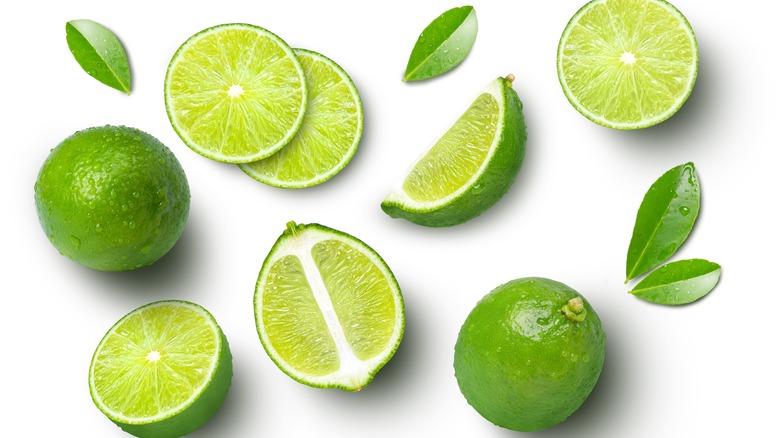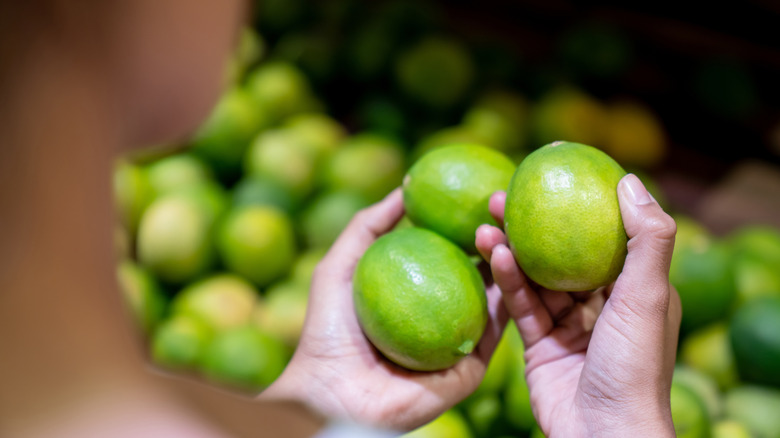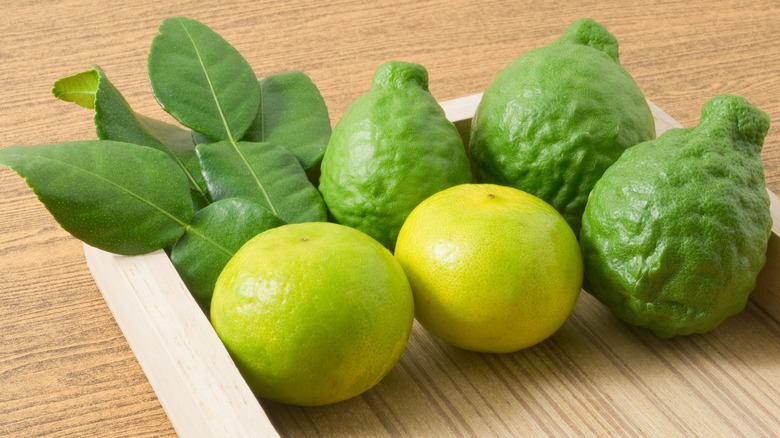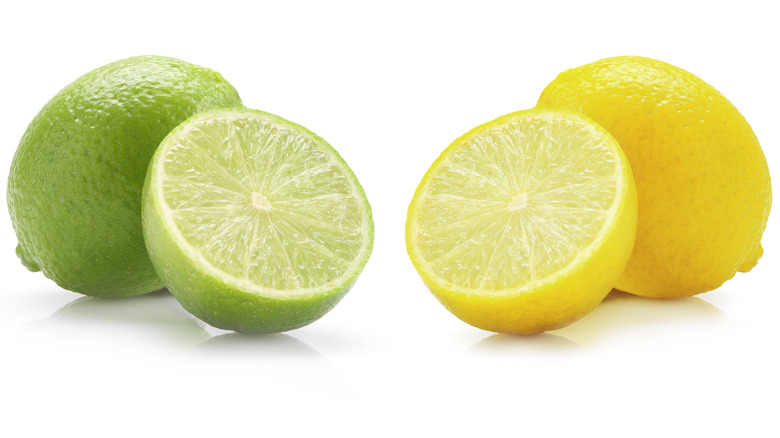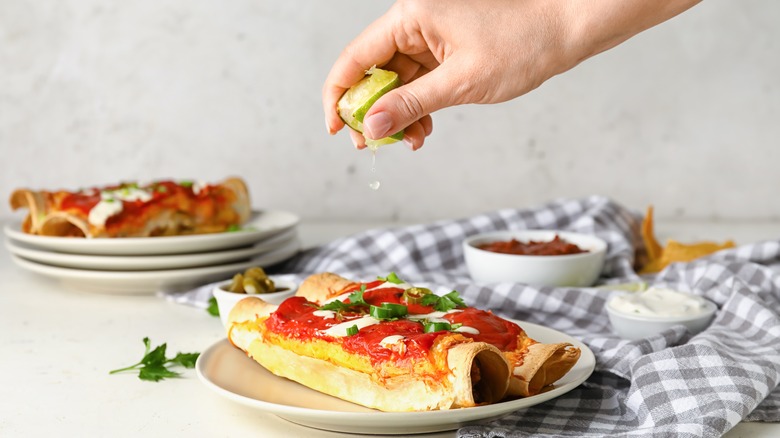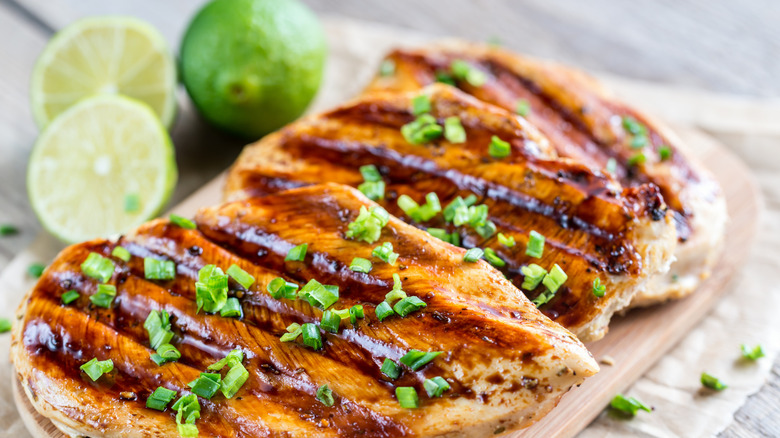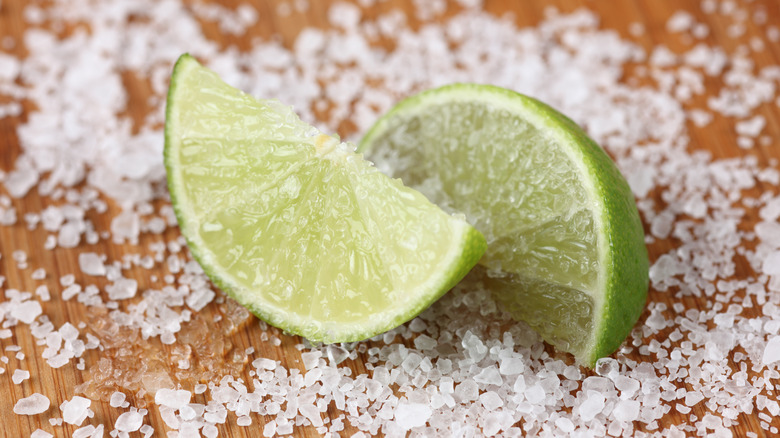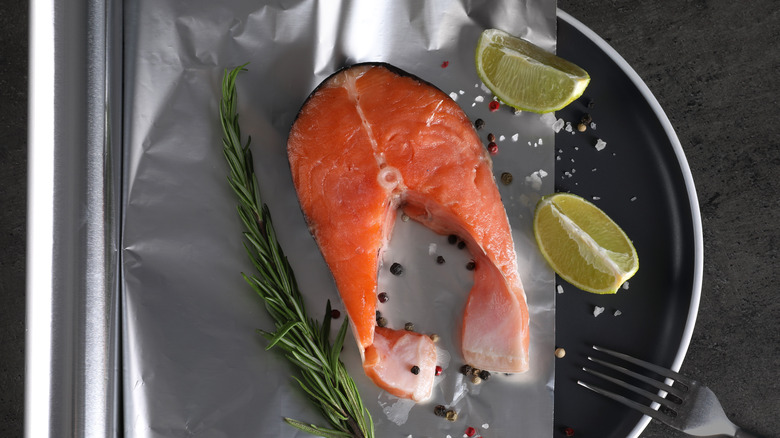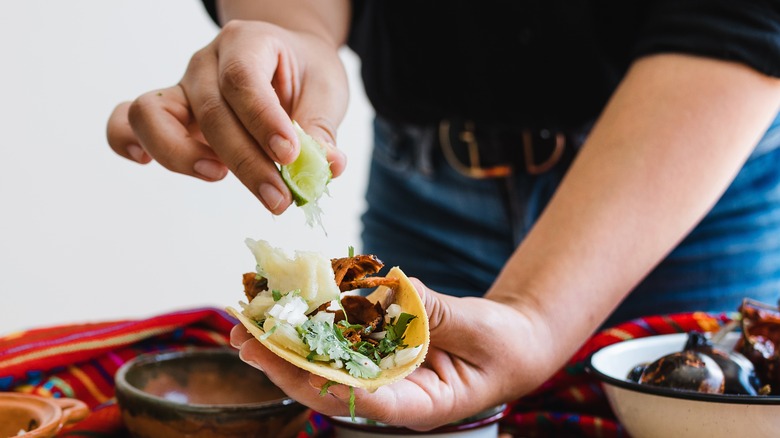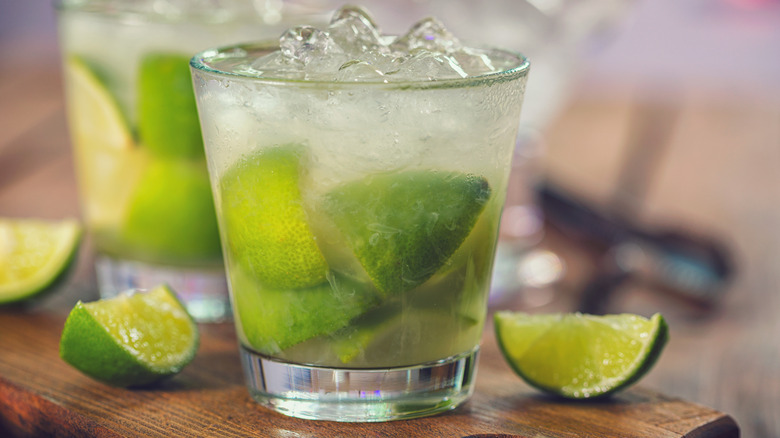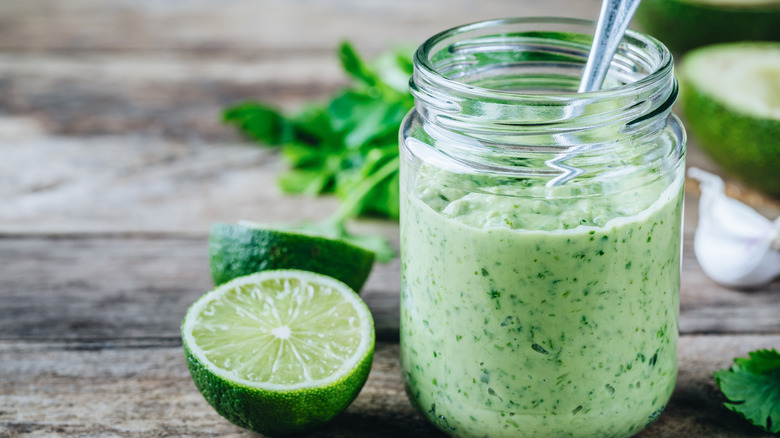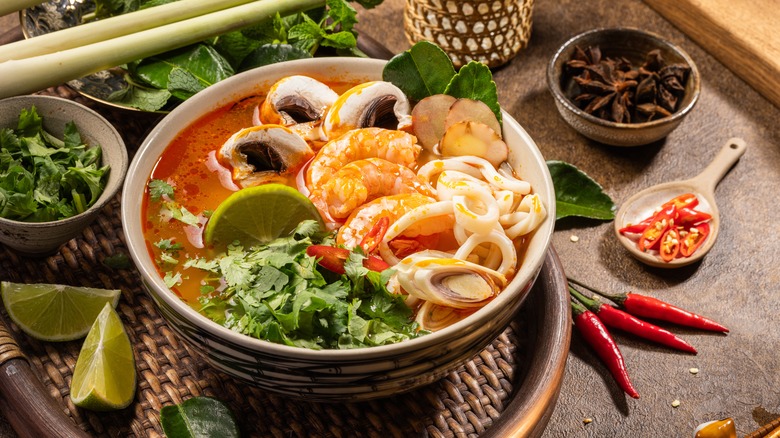13 Tips You Need When Cooking With Limes
With their vibrant green color, firm texture, and tangy taste, limes are versatile citrus fruits capable of elevating any dish (or drink) from ordinary to extraordinary. While limes may already be a familiar sight in your kitchen, there's a good chance you're not utilizing them to their full potential. To get the most out of these green gems, we're diving deep into the art and science of cooking with limes. We start with the basics: selecting the best fruits, exploring the different varieties, and mastering the art of proper storage.
Once you've gotten the fundamentals down, we'll move on to essential techniques such as how and when to substitute limes for lemons and how to slice limes to maximize their juice output. The reward for all of this work is discovering a range of lime-infused recipes that will keep your cooking repertoire fresh in more ways than one. So, if you're ready to add some extra zest to your kitchen, lime up your taste buds, and let's get started.
Choose your limes wisely
If your lime-shopping routine typically involves a quick grab from the grocery store bin before guacamole prep, chances are you haven't really thought about the quality of what you're tossing into your basket. Your selection process is probably limited to grabbing the ones that appear suitably green and lime-sized. Hardly a scientific approach, is it?
Not that choosing high-quality limes has to be difficult. There are just a few things to keep in mind to ensure your coconut-lime shrimp ceviche or margaritas receive the perfect complement. To guarantee maximum lime impact, prioritize selecting vibrant green fruits. This color means they're not fully mature yet, which is actually what you want for the tangiest flavor. As they ripen, they turn lighter green or yellow and lose acidity.
Once you've assessed the color, turn your attention to the peel. You want limes with smooth, shiny skin without blemishes. Avoid ones that are shriveled or feel spongy, as they likely lack juiciness. Then, give them a gentle squeeze. The heavier and firmer they feel, the more juice they're likely to have. Additionally, consider the thickness of the skin. A thinner peel indicates more flesh and juice potential compared to thicker-skinned fruits.
Pay attention to how you store them
If you're like most of us, you've probably been storing limes and lemons wrong for years. Left on the countertop, they'll stay fresh for a week or two, but eventually, they either become soft, moldy, or rock-hard. Some suggest countertop storage to preserve juiciness, but the best way to keep limes fresh is actually in the refrigerator's crisper drawer, where they can last up to three weeks.
If you want to go for extra credit, try storing limes in water before refrigerating. The porous peel absorbs water, keeping the limes juicy and potentially extending their shelf life for up to a month. When dealing with cut-up limes, wrap the leftovers tightly in plastic wrap and store them in the fridge. They might harden and shrink a bit, but there's still good juice to be had.
For longer storage, you can also freeze limes in various forms — whole, sliced, grated zest, or juice. While frozen whole or sliced limes maintain their flavor, their texture becomes soggy, making them less ideal for presentation but perfect for flavoring zesty palomas or other applications where texture isn't as important.
Know the different types of limes
Just as your local supermarket may offer only a handful of apple varieties (and just one type of banana), the lime selection is similarly limited for most people. Despite there being over 20 lime varieties available, the options typically accessible to Americans are few. Among them, the Persian lime, also known as Tahitian or Bearss lime, stands out. These medium-sized limes have a glossy, vivid green skin and juicy greenish-yellow pulp. Widely versatile, Persian limes lend their tangy flavor to dishes ranging from coconut and lime chicken thighs to honey lime salmon.
Another familiar lime variety is the Key lime, also called the Mexican lime. Smaller, rounder, and more aromatic than Persian limes, they offer a sweeter taste and lack seeds. While Key lime pie remains their most renowned application, they're also beloved by bartenders for garnishing margaritas and gin and tonics.
For those seeking a more exotic lime experience, Thailand's Makrut lime is worth exploring. With its thick, lumpy skin and intense fragrance, it offers a slightly bitter, lemongrass-like flavor. Because of this intense bitterness, it's often the zest and leaves of the fruit that find their way into traditional dishes. The leaves are dried, roasted, and cut into strips before being used to season foods like red curry and Tom Yum soup.
Be careful when substituting them for lemons
Lemons and limes are often seen as interchangeable, and while that's often the case, it's not always ideal. Just because you can substitute for the other doesn't guarantee identical results. Limes, for instance, have a sharper, more tart flavor compared to lemons. As a result, you typically need less lime juice to achieve a similar effect. For instance, if a recipe calls for one cup of lemon juice, you'll only need about ¾ cup of lime juice.
However, it's not just about quantities. Flavor matters, too. Lemons lean towards sourness, whereas limes tend to be more bitter. Keep this in mind when swapping one for the other. If you need some help, remember that limes are common in Latin American or Southeast Asian cuisine, whereas lemons are more prevalent in Mediterranean dishes. Additionally, bear in mind that the zest of both fruits contains fragrant essential oils, so recipes heavy on zest will showcase flavor differences more than recipes with juice.
Make sure you get as much juice as possible
While lime wedges and zest have their place, we've gotta get real — lime juice is the star of the show. With its versatility in cocktails, marinades, and chimichurri, getting the most out of every lime is essential. Add to that the fact that medium-sized limes only yield about two tablespoons of juice and the issue becomes that much more important.
Before you put the knife to the peel, prepare the lime by gently rolling it back and forth under your palm. This loosens the flesh, making it easier to juice. Alternatively, a quick 30-second spin in the microwave produces the same effect. When it's time to cut, reach for a serrated knife to slice through the tough peel. Resist the urge to cut through the middle. Instead, opt for a clever lime-cutting hack: Slice the lime lengthwise into three sections, then remove the core. This simple trick makes the lime more flexible, allowing for easier squeezing and more juice. Speaking of squeezing, while your hands work just fine, a reamer or juicer can help you extract even more juice.
Don't add them too early
Getting the timing right when adding ingredients to your dishes is key, almost as crucial as choosing the right ingredients. Certain staples, like onion and garlic, are best incorporated early on, allowing them to soften and infuse the dish with their flavors. On the other hand, delicate ingredients such as fresh herbs and limes are better off added just before serving to keep their aromas vibrant.
The reason for this caution is the citric acid found in limes. While it gives limes their tangy kick, it's easily affected by heat. Exposing it to high temperatures can dull its flavor, resulting in a lackluster dish. Adding lime juice too early can even make your dish bitter and discolored. To ensure your dish bursts with lime flavor without hiccups, add the lime juice after taking the dish off the heat. Similarly, if you're using lime zest, sprinkle it in during the last few minutes of cooking to maintain that zesty freshness.
Try tenderizing meat with lime juice
Let's face it: Most of us don't have the time or patience to marinate meat. We know it can make our dishes more tender and flavorful, but finding the right recipe feels like too much effort. In general, marinades contain salt, fat, and acid. With a pH hovering around 2, lime juice is an excellent option for the acid category.
If you're unfamiliar with using limes to marinate, there's solid science behind it. Lime juice is packed with citric and ascorbic acid, both of which loosen the protein fibers in the meat, giving it a softer, more tender texture. This process, known as denaturing, not only improves texture but also speeds up the cooking process. Reduced cooking time means less moisture loss, resulting in juicy, succulent meat. If you're intrigued, consider trying chili lime tuna steaks. Lime juice combines with brown sugar, soy sauce, oil, and spices to create a quick yet flavorful marinade.
Limes are an antidote to salty food
We've all been there — trying to rescue a bland soup or overly sweet tomato sauce, we accidentally go overboard with the salt. While vinegar, butter, and wine can help fix this sodium overload, each has its drawbacks. Vinegar's strong taste can overpower the dish, butter adds extra fat and calories, and wine can be pricey. Luckily, there's another solution that's subtle, low in calories, and budget-friendly: lime juice.
Acids like lime juice help balance out the saltiness in dishes by rounding out the flavor notes and distracting the palate. While it won't reduce the overall sodium content, it does make the salt's impact less pronounced. When using lime juice to counteract saltiness, remove the dish from the heat to prevent bitter flavors from developing. Additionally, it's best to add the juice gradually to avoid curdling dairy ingredients or ending up with something overly acidic.
Not only is lime juice useful for neutralizing saltiness, but it can also help you cook with less salt overall. Essentially, lime juice enhances the perception of saltiness, making dishes taste more flavorful without the need for additional salt. This allows you to use less salt than usual without sacrificing flavor.
Avoid mixing limes and aluminum
Some culinary combinations simply don't mix well. Take oil and water, baking soda and vinegar, and yogurt and chocolate, for instance. And don't forget to add lime — and any acidic ingredients for that matter — and aluminum to the list. If you've been paying attention, you'll remember that limes contain both citric and ascorbic acid. Both of these can react with aluminum cookware or foil, imparting a metallic flavor and a silvery hue to your food.
Since you'll usually add limes after cooking, this should be fine, but it's worth mentioning if you're working with a lime marinade or lime zest. Although catastrophe is unlikely unless your aluminum pans are scratched, it's still better to err on the side of caution. If you must use aluminum cookware, consider covering the pans with parchment paper or a silicone mat to prevent any unpleasant results.
Massage them into tacos and burritos
Fans of Mexican cuisine are likely accustomed to the ritual of squeezing a wedge of lime over their favorite dishes before indulging. This simple act imparts a burst of freshness to dishes like smoked pork tacos and bean burritos, enhancing their flavor profile and complementing the richness of the other ingredients. However, despite its delicious results, this technique has a drawback.
When you squeeze lime over tacos and burritos, the juice concentrates on the top layer of ingredients. As you munch, you might find yourself repeatedly squeezing more lime juice onto your meal for another hit of that punchy kick. It's a minor inconvenience, but it'll still interrupt your mealtime flow. Thankfully, there's a handy hack to ensure every bite is packed with lime goodness. Before assembling your taco or burrito, rub the inside of the tortilla with a lime wedge as you squeeze it. This clever move spreads the juice evenly, guaranteeing satisfying flavor with every mouthful.
Incorporate them into your favorite drinks
Thanks to their satisfying acidity and remarkable versatility, limes are right at home in a variety of drinks. Their tangy flavor adds a refreshing kick to both alcoholic and non-alcoholic beverages alike. In terms of alcoholic drinks, lime pairs wonderfully with light-bodied Mexican beers like Corona and Modello, where its citrus notes complement the crispness of the beer. It also lends its bright flavor to fruity margaritas, adding a zesty twist to the sweet cocktail. Additionally, classic cocktails such as daiquiris and mojitos benefit from the vibrant acidity of limes, enhancing their refreshing appeal with little effort.
Limes are equally impressive in non-alcoholic beverages like iced tea, mint limeade, and agua fresca. Even a basic glass of water or soda gets a sophisticated upgrade with just a squeeze of lime. Furthermore, using lime slices as a garnish not only adds a touch of style to any drink but also subtly infuses it with citrus flavor, enhancing both its appearance and taste to the last sip.
Use lime juice to make homemade dressing
Hot take: Store-bought salad dressing is overrated. Sure, it's convenient, relatively inexpensive, and tasty enough, but like other commercially made food products, it'll ultimately leave you unsatisfied. So, what's a frequent salad eater to do in order to keep things interesting? The answer isn't swearing off dressing entirely. Rather, with just a few simple ingredients and a couple of extra minutes, you can whip up a complex, flavorful homemade dressing that'll have you reaching for seconds.
Lime juice is a powerful ally when it comes to making salad dressing. For example, this kale and corn salad receives a lovely complement in ginger-lime dressing. All that's required is some grated ginger mixed with olive oil, lime juice, maple syrup, and salt and pepper. Cilantro lime dressing is another excellent option and is easier to pull together. Cilantro, garlic, lime juice, maple syrup, salt, and olive oil combine in a food processor to create a fresh, bright green sauce perfect for all your favorite Mexican dishes.
Experiment with different lime recipes
If we haven't made it clear yet, limes are indispensable ingredients in every kitchen. Despite their small size, they offer loads of brightness, freshness, and versatility. From enhancing tacos and cocktails to enlivening salad dressings, limes are true culinary all-stars.
When it comes to savory dishes, their tangy zest elevates every bite, whether it's tenderizing braised pork, adding vibrant acidity to ceviche, or serving as a zesty marinade for chicken kebabs. But limes don't stop there. They also shine in sweet treats like Key lime pie, lime bars, and Thai lemongrass lime bar cookies. As you can see, their ability to enhance both sweet and savory dishes solidifies limes as essential pantry staples, ready to elevate any recipe with their distinctive flavor profile. So, next time you're wondering what to cook, consider experimenting with lime-based recipes.
Static Media owns and operates Tasting Table, Mashed, and Daily Meal.
